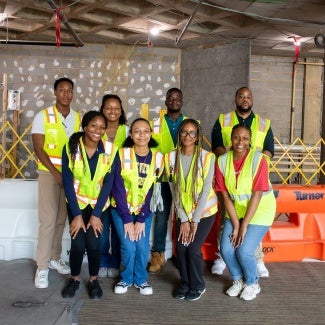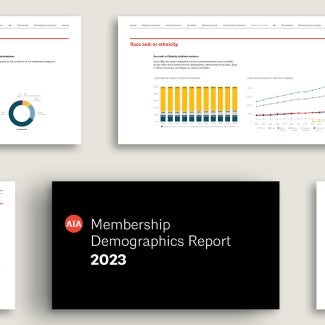Defining the architect's basic services
Contributed by the AIA Knowledge Resources staff
Chapter 15.01 Defining Project Services
Understand the common services of architectural design and the process of design-bid-build to improve your comprehension of the various phases of design services.
Phases of design services
A client’s unfamiliarity with the process of architectural design should not hinder that client’s comprehension of the phases of design services. This Best Practice will help introduce first-time clients to the common services of architectural design and the process of design-bid-build.
Note: The deliverables listed below are examples of common architectural deliverables for each phase but are not required of AIA members.
Schematic design phase services
During the first phase—schematic design—an architect consults with the owner to determine project goals and requirements. Often this determines the program for the project.
The program, or architectural program, is the term used to define the required functions of the project. It should include estimated square footage of each usage type and any other elements that achieve the project goals.
During schematic design, an architect commonly develops study drawings, documents, or other media that illustrate the concepts of the design and include spatial relationships, scale, and form for the owner to review. Schematic design also is the research phase of the project, when zoning requirements or jurisdictional restrictions are discovered and addressed.
This phase produces a final schematic design, to which the owner agrees after consultation and discussions with the architect. Costs are estimated based on overall project volume. The design then moves forward to the design development phase.
Deliverables: Schematic design often produces a site plan, floor plan(s), sections, an elevation, and other illustrative materials; computer images, renderings, or models. Typically, the drawings include overall dimensions, and a construction cost is estimated. Note: The contract may actually spell out what is to be delivered.
Design development phase services
Design development (DD) services use the initial design documents from the schematic phase and take them one step further. This phase lays out mechanical, electrical, plumbing, structural, and architectural details.
Typically referred to as DD, this phase results in drawings that often specify design elements such as material types and location of windows and doors. The level of detail provided in the DD phase is determined by the owner’s request and the project requirements. The DD phase often ends with a formal presentation to, and approval by, the owner.
Deliverables: Design development often produces floor plans, sections, and elevations with full dimensions. These drawings typically include door and window details and outline material specifications.
Construction document phase services
The next phase is construction documents (CDs). Once the owner and architect are satisfied with the documents produced during DD, the architect moves forward and produces drawings with greater detail. These drawings typically include specifications for construction details and materials.
Once CDs are satisfactorily produced, the architect sends them to contractors for pricing or bidding, if part of the contract. The level of detail in CDs may vary depending on the owner’s preference. If the CD set is not 100 percent complete, this is noted on the CD set when it is sent out for bid. This phase results in the contractors’ final estimates of project costs. To learn more about the most common ways owners select a contractor, see Best Practice 05.03.01, Qualifications-Based vs. Low-Bid Contractor Selection.
Deliverables: The construction document phase produces a set of drawings that include all pertinent information required for the contractor to price and build the project.
Bid or negotiation phase services
The first step of this phase is preparation of the bid documents to go out to potential contractors for pricing. The bid document set often includes an advertisement for bids, instructions to bidders, the bid form, bid documents, the owner-contractor agreement, labor and material payment bond, and any other sections necessary for successful price bids. For some projects that have unique aspects or complex requirements, the architect and owner elect to have a pre-bid meeting for potential contractors.
After bid sets are distributed, both the owner and architect wait for bids to come in. The owner, with the help of the architect, evaluates the bids and selects a winning bid. Any negotiation with the bidder for price or project scope, if necessary, should be done before the contract for construction is signed.
The final step is to award the contract to the selected bidder with a formal letter of intent to allow construction to begin.
Deliverables: The final deliverable is a construction contract. Once this document is signed, project construction can begin.
Construction phase services
Contract administration (CA) services are rendered at the owner’s discretion and are outlined in the owner-architect construction agreement. Different owner-architect- contractor agreements require different levels of services on the architect’s part. CA services begin with the initial contract for construction and terminate when the final certificate of payment is issued.
The architect’s core responsibility during this phase is to help the contractor to build the project as specified in the CDs as approved by the owner. Questions may arise on site that require the architect to develop architectural sketches: drawings issued after construction documents have been released that offer additional clarification to finish the project properly. Different situations may require the architect to issue a Change in Services to complete the project.
Deliverables: A successfully built and contracted project.
About the contributor
The Knowledge Resources staff based this Best Practice on definitions in AIA Contract Documents as well as in the 12th, 13th, and 14th editions of The Architect’s Handbook of Professional Practice.
AIA collects and disseminates Best Practices as a service to AIA members without endorsement or recommendation. Appropriate use of the information provided is the responsibility of the reader.
Help build AIA Best Practices by contributing your experience. Contact us with your feedback or ideas for an article.



